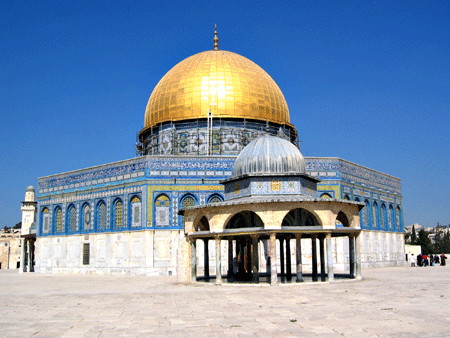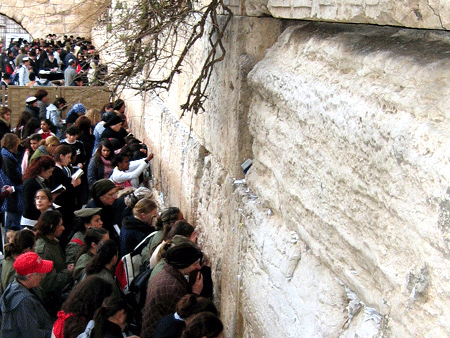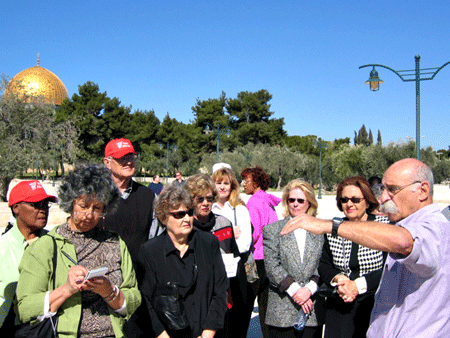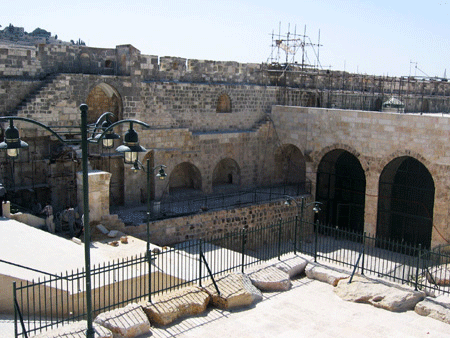|
|
|
 |
|
“BUT THE KING SAID
TO ARAUNAH...'I WILL NOT OFFER
BURNT OFFERINGS TO THE LORD MY GOD THAT COST ME NOTHING,'
SO DAVID BOUGHT THE THRESHING FLOOR
AND THE OXEN FOR FIFTY SHEKELS OF SILVER"
II SAMUEL 24:24
|
|

- I am disturbed that
relics of the Temple Mount are being handled
poorly by the Waqf. Why do they have control
of this area anyway? Can you give me a
little history? I don't want to ignite WW3
but I think the Israelis should not allow any
construction on the Temple Mount without an
archeological team present. What are the
politics of this?
John Casey, San Diego, California
|
The
politics of control of construction on the
Temple
Mount is very complex. If you go back to the
Bible, it says specifically that David bought the
threshing floor of Araunah the Jebusite for 50
shekels of silver. (II Samuel 24:24)
Ironically, this is one of the few passages in the
Hebrew Bible where a deed of sale is registered.
(Other examples are Abraham buying the Cave of the
Machpelah in Hebron as a burial plot for Sarah in
Genesis 23 and Omri, King of Israel buying the hill
from Shemer which became his capital, Samaria, in I
Kings 16.)
Notwithstanding the fact that the Temple Mount
was actually purchased, the normal way to gain
sovereignty was through conquest. The Temple
compound built by David’s heir Solomon was conquered
first by the Babylonian army and then was inherited
by the Persians who conquered Babylon.
Following the Persians, the Greeks, Romans, Arabs,
Crusaders, Arabs once again, Turks, British, Jordan
Arab Legion and finally the Israel Defense Forces
controlled the Temple Mount by dint of conquest. |
|
|
 |
|
Photo: Gila
Yudkin |
|
The Dome of the Chain (foreground)
& Dome of the Rock, built in 691 A.D. |
|
| It was
on the third day of the Six Day War, June 7, 1967,
that the Voice of Israel, the national radio
station, suddenly fell silent. Then the air
waves filled with the music of Naomi Shemer’s
popular song “Jerusalem of Gold.” Her lyrics
included, “The cisterns are dry; the market squares
are empty. And no one goes up to the Temple Mount in
the Old City.” (When she wrote these lyrics, a
month or so earlier, the Temple Mount was “in
Jordan” and no Israelis were allowed to visit.)
After the chorus “Jerusalem of gold, of copper and
of light, Behold I am a harp for all your songs,”
there was a dramatic announcement: |
|
|
Har Habayit bi’yadaynu!!!!
The Temple Mount is in our hands!!!
|
| That was
a rallying cry of ecstatic joy for Jews and
evangelical Christians around the world. A month later, however, Israel’s Minister of
Defense, the photogenic one-eyed Moshe Dayan,
voluntarily gave up administration of the Temple
Mount to the Moslem Religious Trust. To this
day, administration of the Temple Mount – its
cleanliness, opening hours, prayer times, volume of
loudspeakers attached to the minarets, repairs,
fundraising -- resides with the Moslem Religious
Trust, called the Waqf. Security, however, is
guaranteed by the Israel Police. |
|
Tour the Temple
Mount with
Gila's MP3
audio tour in the
company of Abraham and Isaac, David and Solomon,
Jesus and the disciples, the angel Gabriel and
Mohammed. Meet many other luminaries,
both real and legendary.
Gila's Temple Mount tour
is now also available as a written
24-page PDF with a
Temple Mount plan,
guidelines for passing the security check
and ten recommended reads on the
Temple Mount from Gila's bookshelves.
|
After 1967, Israel’s archeological authorities began
to excavate outside the western and southern
retaining walls of the Temple Mount. Today you
can see the results at the Ophel where you can
actually stand on the steps pilgrims once ascended
to reach the Temple, view the Huldah gates and
admire the inscribed stone which toppled over from
the pinnacle.
While the archeologists were busy at the southern
half of the western wall, rabbis in charge of the
“Wailing Wall” surreptitiously began to tunnel under
today’s Moslem Quarter, along the western wall
towards the north. They followed the
flat-bellied Herodion stones all the way to the
northwest corner.
From the late 1980s onwards, I remember crawling
through parts of the tunnel with Jerusalem’s
district archeologist who was showing us guides the
discoveries and explaining their significance. |
|
|
 |
|
Photo: Gila
Yudkin |
|
Worshippers at the Western Wall
public prayer area |
|
Sometime
in the mid 1990s the “Rabbinical Tunnel,” as it was
nicknamed, was opened to the public. The
company I worked for was among the first to embrace
this new attraction. But it quickly became
very popular, for all Israel came to Jerusalem to
see the outer western temple compound wall that had
just become visible, after being buried for two
thousand years.
The tunnel is very narrow in some places, wide
enough for one and a half persons to pass. In
addition,
there’s not that much air, when hundreds of people
are walking through the narrow passageways. The
demand for tunnel tours was so great that our groups were being
given reservations at 11.00 at night, or 6.00
in the morning. Those were tough hours to tour, even
though the destination was so inspiring.
In the meantime, archeologists had discovered a
Hasmonean water channel that predated the time of
Jesus by a hundred years. When they began to clear
it out, there were suggestions that perhaps this
would be an ideal solution for the crowded tunnel. That is, they could make the
Rabbinical Tunnel one
way, by creating an exit through the Hasmonean
channel out to the street above in the Moslem
Quarter. (The exit is, in fact, opposite the
beginning of the Via Dolorosa, at Station One.) |
|
|
 |
|
Photo: Gila
Yudkin |
|
Chief archeologist of the Western
Wall Tunnel, Dr. Dan Bahat on the Temple Mount |
|
To make
a long story shorter, in 1997 at the close of the
Yom Kippur fast, Prime Minister Benjamin Netanyahu
and Jerusalem Mayor Ehud Olmert “opened” the
Hasmonean tunnel. The Waqf claimed that this
was a one-sided move by Israel which harmed the
“status quo” on the Temple Mount. Palestinian
Chairman Yasir Arafat showed fabricated maps
claiming that the Jews were digging under the El
Aqsa mosque. (The tunnel follows the western wall to
the north, whereas the mosque is located way to the
south.)
Just very recently I heard from a senior Israeli
archeologist that there had been an agreement
between the Waqf and Netanyahu and Olmert, to which
he himself was privy. Because the Moslem holy
month of Ramadan took place in the winter of 1997,
the Moslems wanted to use the Marwani Mosque under
the El Aqsa for prayers – but there were only two
doors and safety regulations stipulated they needed
three doors. Initially, Israel did not give
permission to use the Marwani Mosque. |
|
Then
there was an agreement for a swap: the Marwani Mosque
would be allowed to open, and in return, the opening
of the exit of the Western Wall Tunnel would go
without incident. This agreement was made with
the highest Moslem authority, but secretly.
Arafat was also a party to the understanding, but
used the tunnel opening to inflame the political
situation to his advantage.
Riots broke out in Jerusalem and around the country
with a high number of casualties: 6 Israelis and 70
Moslems dead. Israelis then stopped visiting
the Rabbinical Tunnel for which so much blood had
been shed. Eventually things calmed down. |
|
|
COMING TO
JERUSALEM?
BOOK GILA for your customized private tour |
|
When Ehud Barak became prime minister in 1999, he
began negotiations towards a permanent agreement
with the Palestinians. At the same time, his
government ignored the new large-scale Moslem
construction on the Temple Mount.
With foreign funds and donation of work-time by
Moslems from the Galilee, the Waqf began building a
mosque in the area called Solomon’s Stables in the
southeastern corner of the Temple Mount. The
original building had nothing to do with Solomon –
that was the Crusader name for their own stables.
The arched passageways were part of the underground
structure of Herod’s Second Temple. I was
underneath a number of times in the 1990s (before
the massive Moslem construction) and I could clearly
see that the architecture was Herodion. |
|
|
 |
|
Photo: Gila
Yudkin |
|
SE corner of the Temple Mount,
location of the underground Solomon's Stables |
|
During
the winter, spring and summer of the year 2000, as I
led group after group, week after week, up onto the
Temple Mount to visit the Dome of the Rock and the
El Aqsa, I found it hard to concentrate on my
commentary. I was counting tractors and small
bulldozers which were noisily moving around on the
Temple Mount removing tons of dirt. I kept
wondering to myself, “Hey -- What’s going on here?”
It seemed there was a conspiracy of silence.
Perhaps there was – for the Barak government at that
time was negotiating with the Palestinian Authority
over possible solutions to the century-old conflict.
Later I found out that a very prominent group of
Israeli archeologists, writers and intellectuals had
written a petition to the government, calling the
lack of supervision on the Temple Mount an
archeological crime. They demanded that the
government stop the Waqf’s excavations in front of
the El Aqsa Mosque. But there was no response.
As you imply, John, in your question, the relics
found on or under the Temple Mount are part and
parcel of our Judeo-Christian heritage. In
practical terms, the Waqf was given a free hand with
absolutely no supervision. At least seventy
truckloads of dirt were taken out from Solomon’s
Stables and dumped in the Kidron Valley.
Fortunately, archeologist Dr. Gaby Barkay, excavator
of the Ketef Hinnom tombs where the
Priestly
Benediction was found, took the initiative. He
raised money for a salvage expedition to move the
dumped dirt into containers. Currently they are being
sifted and then the finds are sorted by size.
This is not what is called a “controlled” excavation
where you can date the material according to which
level it is found, but this is the best that can be
done under the circumstances.
One of the important finds is a bulla, a round clay
seal affixed to documents, from the First Temple
period. Dr. Barkay identified the seal as
possibly belonging to a person named Galihu Ben
Immer. The Ben Immer famly is mentioned in the Book
of Jeremiah. Barkay told reporters, "This is the
first time we have an artifact bearing an
inscription from the First Temple period, whose
source is incontrovertibly the Temple Mount."
He said in finding this artifact, it’s as if we
received "greetings directly from the kings of the
House of David."
According to an article in the Biblical Archeology
Review, 10% to 20% of the finds are from the First
Temple period. Pottery shards include
hand-burnished reddish pottery characteristic of the
time of Solomon. Over a hundred ancient coins
were found and lots of fragments of jewelry from
gold, silver, bronze and bone. Several Second
Temple period oil lamps were found decorated with
the seven-branched menorah which once stood in the
Temple.
“The Temple Mount,” says Dr. Barkay, “is terra
incognita. It is amazing. To this day
not one shard has been published from the Temple
Mount. There has never been a controlled,
normal scientific dig within the Temple Mount.
We have controlled Jerusalem for more than 30 years,
but we do not even have an archaeological
survey of
surface data. No one ever bothered, from the
start of the researching
of Jerusalem, to collect
potsherds inside the mount."
The reason for this, according to Gaby, is that "in
Jerusalem everything you touch is political, and the
Temple Mount is super-political, and people flee
from it like a fire….The politics of Jerusalem
scares them off. The politics of the Temple Mount is
twice as scary.” |
|
Copyright 2006,
20010
Gila Yudkin. Permission needed for any reuse. |
|
|
|
Coming to Jerusalem this
year? Would you like to find the
venues
where you can
quietly be transported back in your imagination to
the time of Jesus? David? Abraham?
Gila's Guide
will lift up your spirit as you "Explore
Jerusalem's Soul." This updated PDF (Adobe Acrobat) 46-page
guide gives you the Top Ten places to meditate on
the Bible, the Top Ten lesser-known churches worth
visiting, the Top Ten most rewarding roof-top views
and the Top Ten places for sampling yummy Middle Eastern soul
food. More...
|
|
Considering leading a Holy
Land tour? Then don't miss the
"A to Z for
Holy Land Tour Leaders." |
|
|
Read about
Charles
Warren, the 19th century explorer who
excavated under the Temple Mount by digging
shafts and tunnels. |
|
Tour the Temple
Mount in the
company of Abraham and Isaac, David and Solomon,
Jesus and the disciples, the angel Gabriel and
Mohammed -- and Gila. Meet many other luminaries,
both real and legendary.
Gila's Temple Mount tour
is now available as a written
24-page PDF with a
Temple Mount plan,
guidelines for passing the security check
and ten recommended reads on the
Temple Mount from Gila's bookshelves.
|
| "Ten
Tips for a Terrific Temple Mount Tour"
suggests how to reap the maximum inspiration during your
visit to the Temple Mount. |
|
|
|
GILA
YUDKIN
•
TCHERNIKOVSKI
64A
•
JERUSALEM
•
ISRAEL
gila@itsgila.com
HOME
•
BOOK
GILA
•
TIPS
FOR TOURS •
ABOUT GILA
|
|

